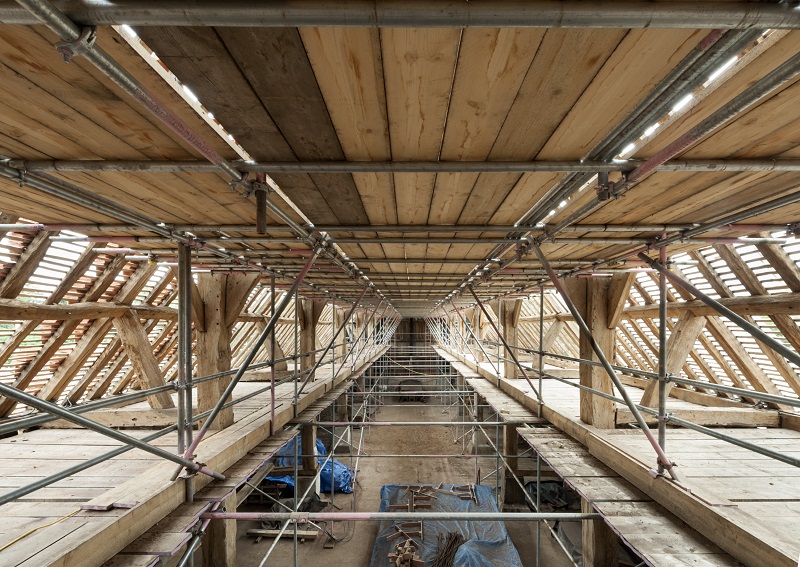Finding the Benefits of Scaffolding for Professionals and Building And Construction Workers
The execution of scaffolding in building jobs works as an important aspect for enhancing operational performance and safety and security. By providing steady accessibility to raised workplace, scaffolding not only reduces the risk of falls yet also streamlines process for numerous trades associated with a job. Its versatile nature allows for application across a wide range of building situations, potentially leading to considerable cost financial savings. Nonetheless, the complete scope of scaffolding's benefits expands past plain capability and security-- there are deeper ramifications that require further expedition.

Improved Employee Safety
Improved worker safety and security is an extremely important worry in the building sector, specifically when it comes to making use of scaffolding. Effectively created and mounted scaffolding systems supply crucial assistance for employees running at elevations, substantially reducing the danger of falls, which are among the leading reasons of deaths in building.
Scaffolding boosts safety and security with its structural honesty and style features that allow for steady work systems. Top quality scaffolding products, such as steel or aluminum, offer longevity and stamina, ensuring that they can stand up to the weight and motion of materials and employees. Safety procedures such as guardrails, toe boards, and gain access to ladders are crucial elements that stop injuries and mishaps.
Routine evaluations and maintenance of scaffolding are essential to maintain safety standards. Spending in proper scaffolding remedies is not merely a regulatory requirement; it is an essential aspect of advertising a secure working setting in the building and construction sector.
Improved Availability
Accessibility in the construction industry is important for advertising effectiveness and productivity on work websites. Scaffolding gives a versatile solution that substantially enhances access for service providers and building employees. By supplying steady systems at various heights, scaffolding allows employees to reach elevated areas safely and efficiently, minimizing the need for cumbersome ladders or awkward settings that can prevent progression.
The style of scaffolding systems permits simple motion of personnel, devices, and materials, improving workflows and decreasing hold-ups. With correct scaffolding in position, employees can work together more properly, as several staff member can operate all at once in a restricted room without endangering safety and security or access. This adaptability is especially valuable in complicated building and construction tasks that need constant changes in elevation or placement.
Additionally, scaffolding can be tailored to fit specific project demands, ensuring that all areas are accessible despite the building's architecture. By boosting access, scaffolding not only boosts the workplace however likewise adds to a more well organized site, thus advertising a culture of efficiency and security. In summary, enhanced availability through scaffolding is a crucial aspect in enhancing the performance of building and construction teams.
Boosted Efficiency
The implementation of scaffolding not just enhances ease of access however additionally plays a substantial role in raising efficiency on building and construction websites. By supplying a safe and stable system, scaffolding enables workers to do tasks at height with higher blog here simplicity and safety. This decreases the time invested moving materials and tools, as every little thing required is within arm's reach. Employees can focus on their particular tasks without regular disturbances.
In addition, scaffolding allows multiple trades to function simultaneously, improving partnership and quickening job timelines. As an example, while one crew is installing electric systems, an additional can deal with plumbing or ending up jobs on the same degree, lessening downtime. The critical layout of scaffolding additionally assists in quicker movement across the website, removing the requirement for continuous elevation adjustments or excessive ladder use.

Cost-Effectiveness
While numerous might at first regard scaffolding as an additional expense, its implementation really adds to significant cost-effectiveness on building jobs. By facilitating more secure and extra reliable work settings, scaffolding decreases the threats of mishaps and injuries, which can result in pricey delays and increased insurance premiums.
In addition, scaffolding boosts productivity by providing workers with immediate accessibility to several levels of a framework. This availability not just increases the speed of building yet also minimizes labor costs, as workers can complete tasks much more promptly without the requirement for difficult ladders or lifts.
Additionally, the modular nature of scaffolding enables adaptability in its use across various jobs, leading to reduced rental expenses when contrasted to less versatile alternatives. The ability to recycle scaffolding for different jobs additionally amplifies its cost-effectiveness, making sure a higher return on financial investment.
Versatility in Applications
Frequently acknowledged for its flexibility, scaffolding serves a wide variety of applications in the building industry. Its adaptability permits use in various jobs, from property structures to large industrial advancements. Scaffolding systems can be personalized to fit different website problems, accommodating special architectural styles and elevations.
In addition to traditional building, scaffolding is also vital for repair and maintenance tasks. Whether it involves paint, home window installation, or exterior remediation, scaffolding offers a steady system that enhances employee safety and performance. Its modular layout enables for fast assembly and disassembly, making it optimal for jobs with tight timelines.
Moreover, scaffolding is not restricted to vertical frameworks; it can be successfully made use of in bridge building and construction, industrial centers, and even momentary occasion areas. The capacity to adapt scaffolding for different environments makes sure that service providers can fulfill diverse job requirements without jeopardizing security or access.
This multifunctionality highlights the value of scaffolding in modern construction techniques, making it possible for service providers and construction employees to implement their tasks with greater adaptability and accuracy. Eventually, the adaptability of scaffolding contributes significantly to the general success of construction jobs Read Full Article across numerous fields.

Verdict
In summary, the advantages of scaffolding for contractors and building workers are significant. Enhanced employee safety decreases autumn risks, while boosted accessibility ensures that raised areas can be gotten to effortlessly. Increased performance is accomplished through smooth operations, and cost-effectiveness is understood by enhancing resource allocation. The convenience in applications allows scaffolding to adjust to various task needs. Collectively, these advantages add to a more secure, a lot more productive, and economically practical construction environment.
The implementation of scaffolding in building and construction jobs serves as an essential element for improving functional effectiveness and safety. Scaffolding gives a versatile service that considerably improves ease of access for contractors and building and construction workers. In summary, enhanced ease of access through scaffolding is a vital factor in optimizing the performance of building and construction groups.
The execution of scaffolding not just boosts ease of access but also imp source plays a substantial duty in enhancing efficiency on building sites. Temporary Roof Scaffolding.In recap, the benefits of scaffolding for service providers and building and construction workers are substantial